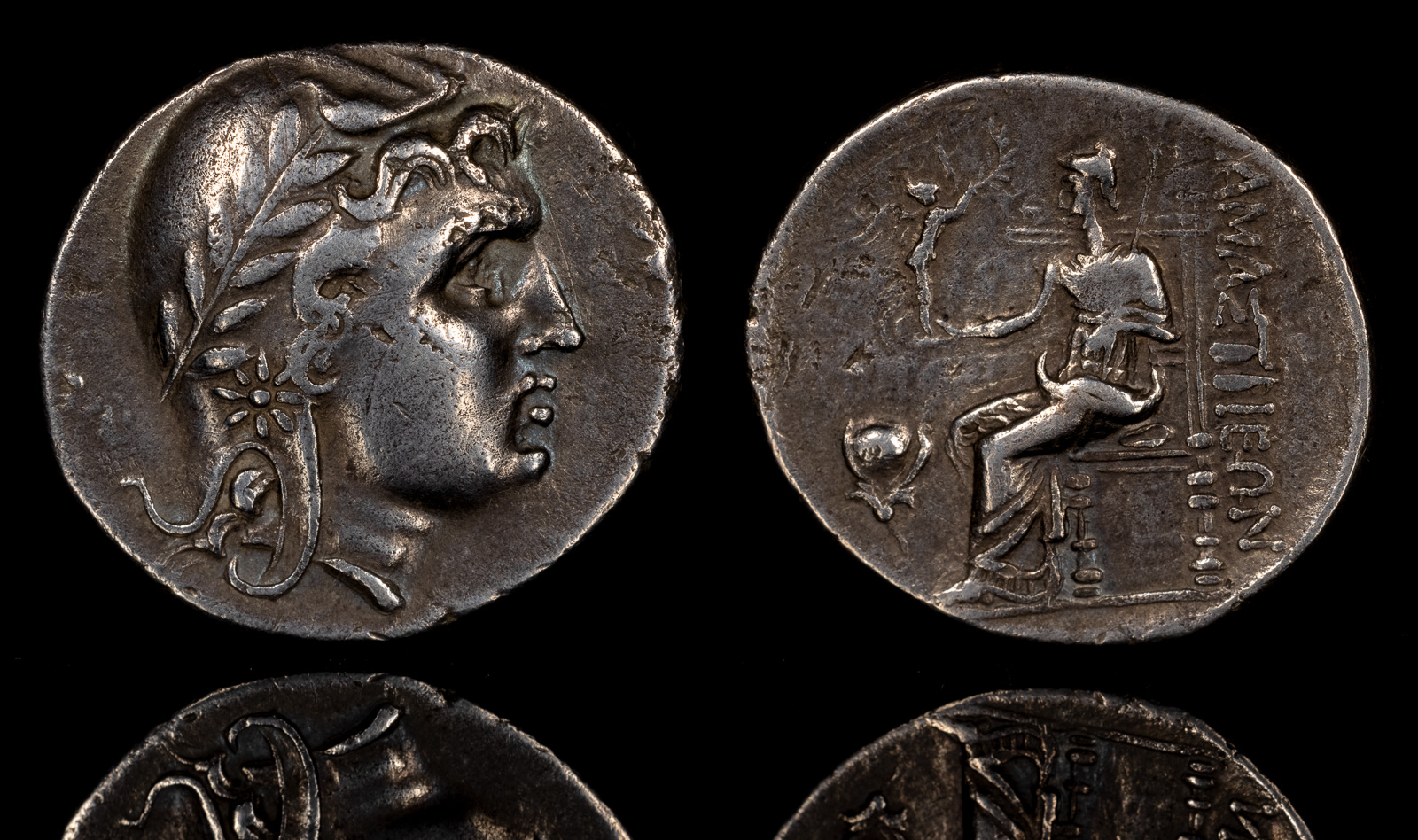
PAPHLAGONIA, Amastris. Circa 285-250 BCE
AR Stater 23mm, 8.88 g, 12h
Head of Mên right, wearing Phrygian cap decorated with laurel branch and star / Aphrodite seated left, holding in extended right hand Nike, who crowns her with wreath, and cradling lotus-tipped scepter in left arm; rose to left.
Callataÿ, Premier, Group 2, 43 (D17/R21 – this coin); RG 5; HGC 7, 356
Ex Sigmund Collection.
Ex CNG March 1999
This is the first coin minted by a woman in her own name. However, if you simply dismissed it as that, you would miss a tremendously interesting history and a little bit of controversy.
Amastris, who was the niece of the Persian “King of Kings” Darius III, wound up marrying three major participants during the Era of the Diadochi. The first was Krateros, who wasn’t fond of the forced marriage at Susa instigated by Alexander the Great. He had grander plans, specifically to marry Phila, a daughter of Antipater.
Once Alexander was out of the picture, Krateros made his move. However, being a gentleman, he ensured that Amastris was well-provided for by matching her with Dionysios of Heraklea Pontika. Krateros was then free to go die on the battlefield against Eumenes.
With Dionysios, Amastris had two sons. This in itself is remarkable given that Dyonysios was renowned as an obscenely fat man. He is said to have grown so obese that he couldn’t eat by natural means and died by choking on his own fat.
Things may have turned for the better when she married Lysimachos, who although aged sixty was at least fit enough for battle. However, he soon abandoned her for Arsinoe II, who ended up convincing him to kill his eldest son Agathokles, which eventually ended his kingdom and life.
However, Amastris by then had grown sick of husbands. She moved back to Heraklea Pontika, and, in complete annoyance to her sons by Dionysios, ruled herself. After all, the men in her life hadn’t shown themselves for excellence, so why not? She issued her own coins, and to this day we debate what they portray.
The real debate is the person with the smurf hat on the obverse. Is this the lunar god Mên, the god Mithra (of no relation to Mothra), or Amastris herself? Most numismatics today no longer believe this is Mên, but are evenly split between Mithra and Amastris herself. Would she have dared to put herself on a coin? That was ballsy, even for men (as in “males”, not Mên) back then.
Regardless what she put on her coins, her sons weren’t too happy that they weren’t ruling. So, they suggested a nice sailing day on the lake, took her out, and drowned her. Lysimachos, who wasn’t dead yet when this happened, was extremely upset of the demise of a woman he highly valued, so he headed out there and executed both sons. Back then there was no “time out” for bad behavior.
The name of her capital, Amastris, lived on. Today, it’s a town in Turkey called Amasra, but the Greek name remains the same.
Probable birth year of Amastris to Oxyathres, the brother of Darius III.
Amastris married to Krateros by Alexander the Great at the Susa Weddings.
Dionysios of Herakleia Pontika marries Amastris, after her first husband Krateros divorces her to marry Phila, the daughter of Antipater.
Birth of son Klearchos to Amastris and Dionysios of Herakleia Pontika.
Birth of son Oxyathres to Amastris and Dionysios of Herakleia Pontika.
Death of Dionysios at Herakleia Pontika. The kingdom is left to his wife Amastris.
Lysimachos takes control of Herakleia Pontika and marries Amastris.
Amastris travels to Sardis with Lysimachos, who turns his attention to Arsinoe II. Amastris returns to Herakleia Pontika.
The city of Amastris is founded by Amastris, a Persian princess and the niece of the Persian king Darius III. She establishes the city by combining four smaller settlements: Sesamos, Kytoros, Tios, and Kromna.
Amastris is drowned by her two sons, Klearchos and Oxyathres. The two brothers take over Herakleia Pontika.